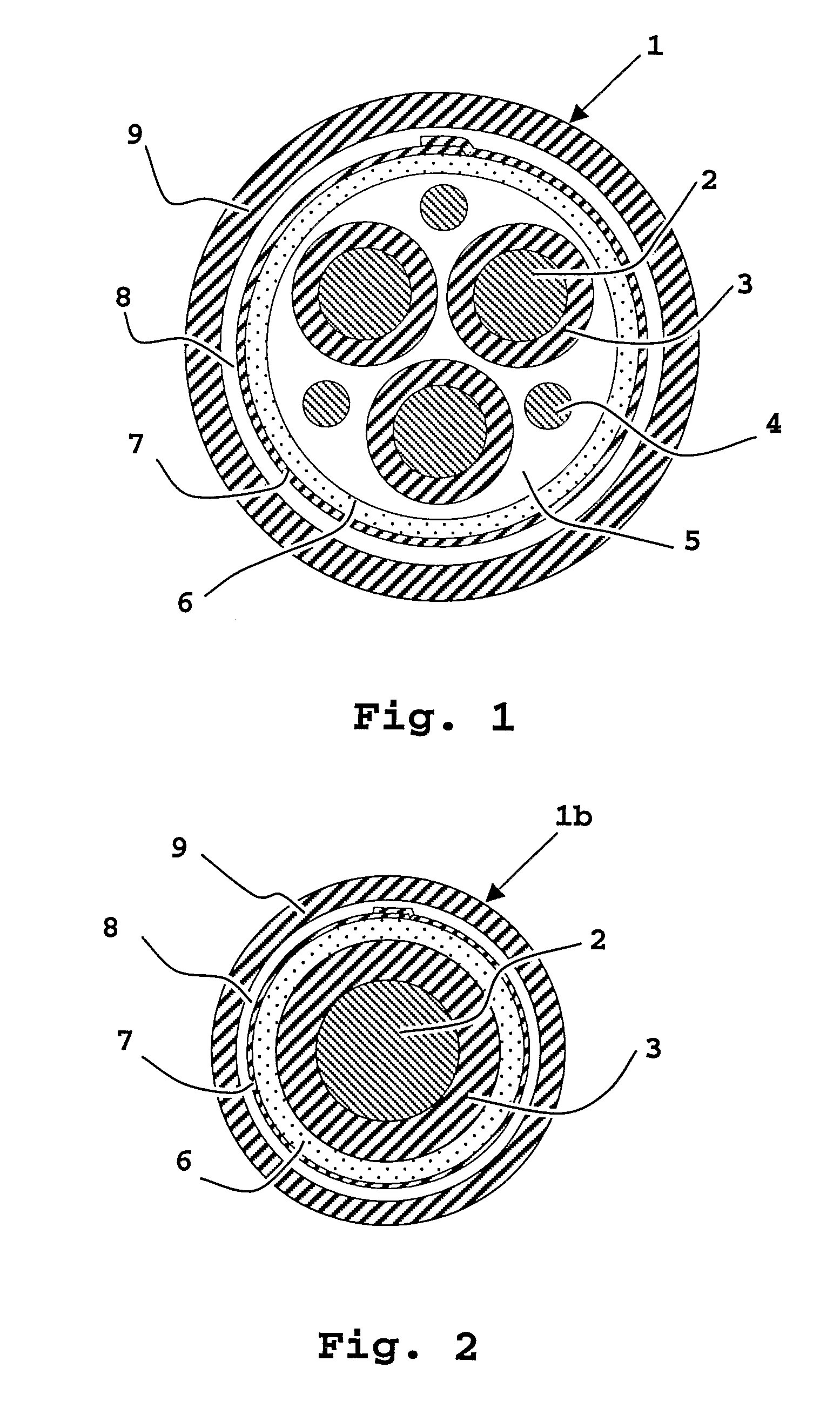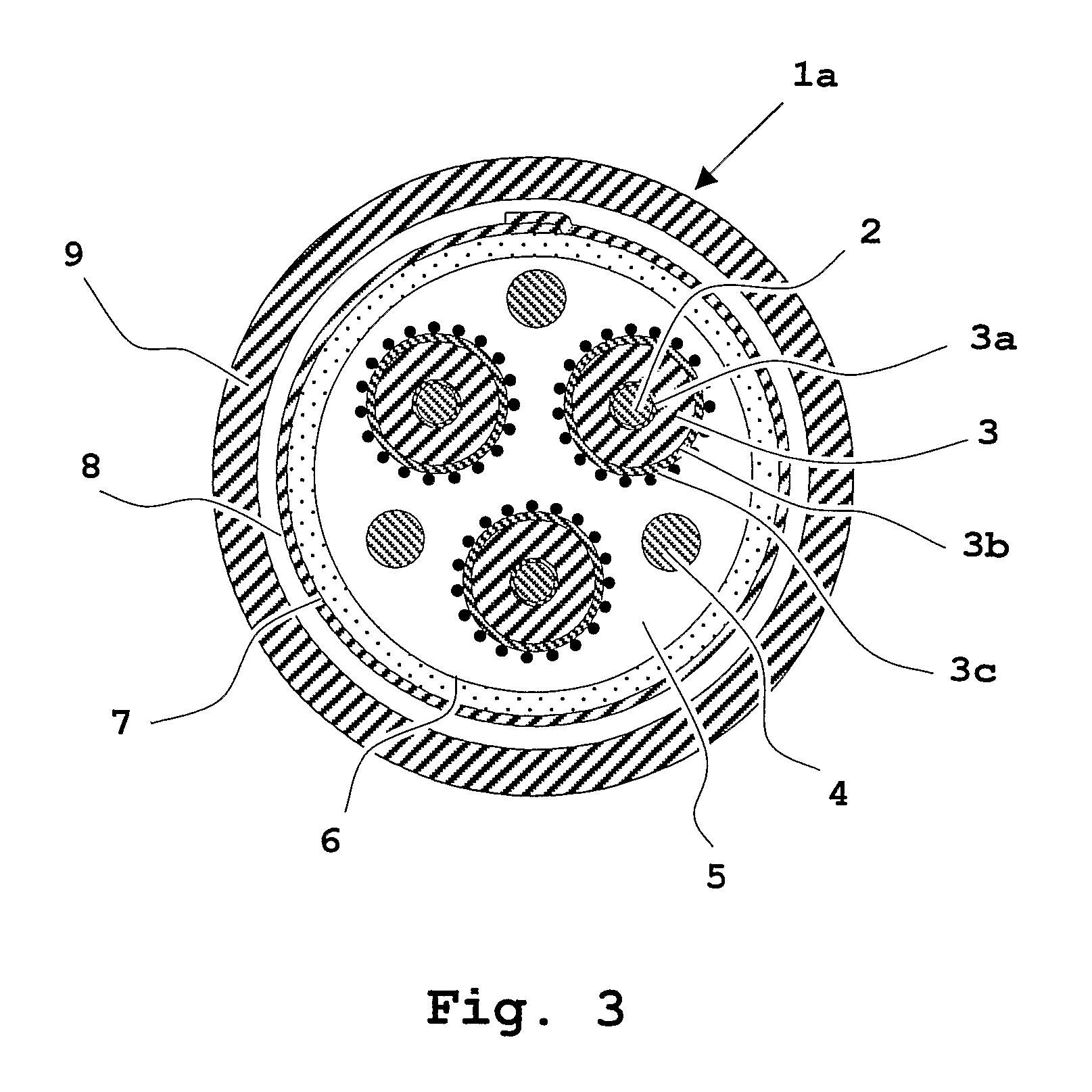Process for manufacturing a cable resistant to external chemical agents
a technology of chemical agents and manufacturing processes, applied in the manufacture of power cables, cable/conductor materials, plastic/resin/waxes insulators, etc., can solve the problems of compromising the overall lifetime performance of the cable, mechanical properties, and the increase of the weight of the sheath, so as to achieve the effect of effective sealing and greatly improve the coupling between the coated metal tape and the polyamide layer
- Summary
- Abstract
- Description
- Claims
- Application Information
AI Technical Summary
Benefits of technology
Problems solved by technology
Method used
Image
Examples
example 1
Cable Production
[0146]A medium-voltage cable of the tripolar type was prepared according to the construction scheme given in FIG. 3.
[0147]Each of the three cores possessed by said cable consisted of a copper conductor (of cross section equal to 150 mm2) coated on the extrusion line with a 0.8 mm thick internal semiconductive coating layer, a 5.5 mm thick insulating coating layer, a 0.5 mm thick external semiconductive coating layer, the three coating layers being made of a crosslinked ethylene / propylene rubber based compounds. The extrusion was carried out by means of a triple extrusion line which comprises: a 80 mm, 25 D single-screw extruder for the internal semiconductive coating layer, a 150 mm, 25D single-screw extruder for the insulating coating layer and a 90 mm, 25D single-screw extruder for the external semiconductive coating layer. The temperatures in the various zone of the extruders were, respectively, the following: 50-100-110-120-120° C., extrusion head 115° C.; 80-90-...
example 2
[0167]A cable was produced as disclosed in Example 1, the only difference being the fact that the continuous layer made of a polyamide 6 / linear low density polyethylene (LLDPE) blend (Orgalloy® LE 6000 from Atofina) was extruded at a draw down ratio (DDR) of 4.0.
Adhesion (Peeling) Test
[0168]Test pieces of the metal tape with the adhesive layer and the continuous coating layer with the following dimensions 10 mm width×100 mm length were obtained from the cable. Test pieces having the same dimensions were also obtained from the cable of Example 1.
[0169]Said pieces, were subjected to the peel test according to Standard EDF NF C 33-223 using an Instron 4202 dynamometer, the clamps of which were applied to the metal tape at one end and to the continuous coating layer at the other end (the two end were manually peeled off before applying the clamps). A traction speed equal to 50 mm / min was then applied and the peel force (PF) values thus measured, expressed in Newtons (N), are given below...
PUM
| Property | Measurement | Unit |
|---|---|---|
| temperature | aaaaa | aaaaa |
| temperature | aaaaa | aaaaa |
| density | aaaaa | aaaaa |
Abstract
Description
Claims
Application Information
 Login to View More
Login to View More - R&D
- Intellectual Property
- Life Sciences
- Materials
- Tech Scout
- Unparalleled Data Quality
- Higher Quality Content
- 60% Fewer Hallucinations
Browse by: Latest US Patents, China's latest patents, Technical Efficacy Thesaurus, Application Domain, Technology Topic, Popular Technical Reports.
© 2025 PatSnap. All rights reserved.Legal|Privacy policy|Modern Slavery Act Transparency Statement|Sitemap|About US| Contact US: help@patsnap.com



